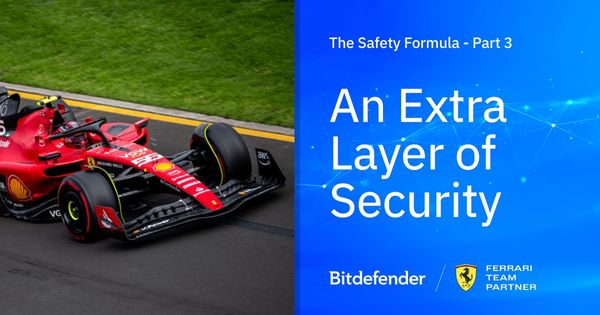The Safety Formula - Episode 3: VPNs and Survival Cells. Secure and Protected

This season, the Bitdefender logo will appear on the driver’s helmets and the Halo bar of the Ferrari SF-23 Single-Seater, two of the most critical safety elements designed to protect drivers.
In our micro-series, The Safety Formula, we explore the worlds of cutting-edge Formula 1 technology and innovations in the ever-evolving world of cybersecurity. Welcome to Episode 3, where we look at the Formula 1 Survival Cell and VPNs, two elements keeping things secure and protected.

A Fortified Environment
As drivers Charles Leclerc and Carlos Sainz take their positions in the Ferrari SF-23, what they settle into is no ordinary seat. Within the confines of their meticulously-crafted single-seater cockpit, they are cocooned in what is known as a monocoque, or Survival Cell.
Reducing Risk
The Survival Cell is at the core of the Formula 1 car, supporting the front suspension and rear engine. It is also where the driver sits, and safety considerations take precedence within this critical space which acts as the last line of defense between the driver and track.
The standard Survival Cell is made from carbon fiber composite (long, thin strands of carbon atoms bonded together in an incredibly strong ‘weave’) with a layer of penetration-resistant Kevlar.
The Survival Cell cockpit has reinforced areas around the legs, head, and torso and is designed to absorb energy from impact, which helps reduce the risk of injury to the driver in extreme situations.

Enhancing Performance
In the 1980s, the development of carbon fiber technology revolutionized the construction of Survival Cells. Strength is just one of carbon fiber’s many advantages. It’s also much lighter than metal with strong heat resistance, making it ideal for high-performance racing.
As well as greater protection for the driver, the Survival Cell chassis helps to enhance a car’s performance–its rigidity improves the car’s handling and aerodynamics while also reducing weight.
A Virtual Safe Haven
In cybersecurity, like in Formula 1, zero risk will never exist. But just as safety is a priority area of work for teams and the FIA, cybersecurity technology incorporates safety-focused measures to reduce risks in the digital world.
While Survival Cells are a safe haven for drivers in Formula 1, in the digital world, VPNs (Virtual Private Networks) offer the equivalent fortified environment for users.

Safe and Secure
The primary role of a VPN is to establish secure connections over the internet. In the online world, risks like personal data theft exist and users need to outmaneuver these obstacles to stay safe.
VPNs use encryption to scramble data sent between a user's device and the VPN server. This encryption ensures that even if intercepted, the data is unusable to unauthorized parties like data thieves. This is particularly important when using public Wi-Fi networks in cafes or airports.
Just as the survival cell shields the driver in a Formula 1 car, VPNs surround users with a layer of security, protecting their data, privacy, and online identity and keeping sensitive information from being compromised.
Both survival cells and VPNs exist to create a protected environment for their respective users. While survival cells primarily focus on physical safety in the context of Formula 1, VPNs address digital safety to protect users’ data online. A line of defense, both Survival Cell and VPNs keep things safe and secure.
tags
Author

The meaning of Bitdefender’s mascot, the Dacian Draco, a symbol that depicts a mythical animal with a wolf’s head and a dragon’s body, is “to watch” and to “guard with a sharp eye.”
View all postsRight now Top posts
Start Cyber Resilience and Don’t Be an April Fool This Spring and Beyond
April 01, 2024
Spam trends of the week: Cybercrooks phish for QuickBooks, American Express and banking accounts
November 28, 2023
FOLLOW US ON SOCIAL MEDIA
You might also like
Bookmarks








